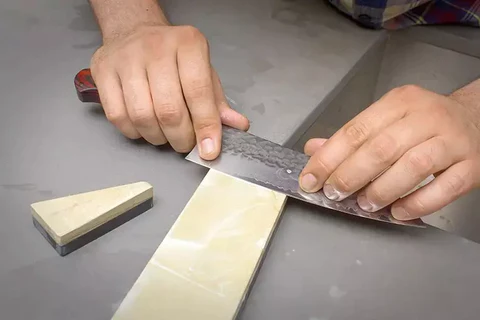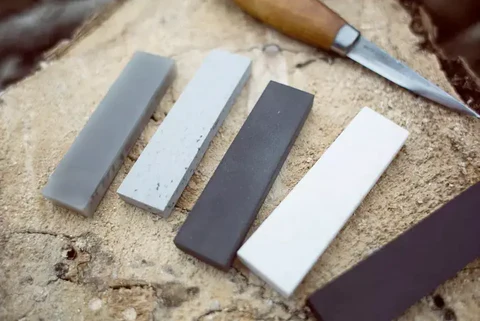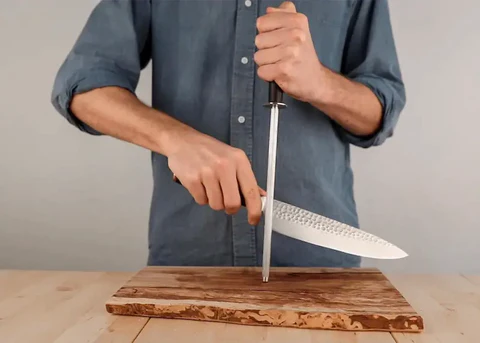How to sharpen a knife with a water stone?
Sharpening aknife with a water stone is a trend among kitchen professionals because it is less aggressive than other more conventional methods.
Submerge the stone in water for 4 hours. Once the time is up, take it out and place it on the workspace.
Keep it moist at all times. This creates a paste that helps sharpen. To sharpen your knife, you should use stones of different grits depending on the condition and material of the knife. If it is very dull, we recommend shaping it with a 500 stone. If you want to sharpen it more finely, we recommend using a 1,000 to 4,000 stone. To sharpen your knife, place the blade of the knife on the stone at a 45-degree angle. Start at the tip by sliding the knife about ten times. Carry out the same process from the different areas of the blade to the base. Once sharpening is complete, polish the knife with a stone of at least 5,000. Finally, after washing the knife to remove impurities, it is ready to be used in the kitchen.

The water sharpening stone
To re-sharpen your knives, it is necessary to have a sharpening stone. Normally, sharpening stones have a dual function:
- The coarse grain area (400gr) is used to roughen and correct imperfections that appear on all knives, while recovering the lost angle
- The fine grain (1000 gr) is the one that really sharpens the blade

For it to work properly, it is advisable to soak the stone in water for 5 to 10 minutes. You will know that the stone is ready when it stops expelling air bubbles. In addition, the stone must always remain wet throughout the process. Place the non-slip side upside down on the wooden base. During sharpening, a gray liquid is produced, which improves the sharpening process.
Knife tilt and angle relative to the sharpening stone
The quality of our knife's edge depends on the correct positioning of the knife and the alignment of the edge with the sharpening stone.
Once you have removed the stone from the water and placed it on a stable surface, you need to place the knife blade on the stone at a 45 degree angle to the longitudinal axis of the stone.
Start by using the coarsest grit stone (the 400 grit stone). Place the blade on the stone and lift the blade slightly, leaving a space where two coins could fit, at about a 15- to 20-degree angle. Hold the knife handle firmly with one hand, with the blade facing you, and place your free hand on the blade, keeping it away from the edge so you don't cut yourself.

Sharpening a Kitchen Knife Using a Water Whetstone
Maintaining this angle and applying pressure to the stone, rub the edge of the knife lengthwise along the stone at intervals of 20 to 30 strokes across the stone in both directions, applying light pressure. You will know that sharpening is taking place when you see a burr coming out of the edge. If you cannot see it with the naked eye, gently touch it with your fingertip. You will feel it because the edge will be rough.
It is highly recommended to divide the knife into thirds and make 20-30 passes over the stone on each third of the knife. This ensures that the entire edge of the knife is properly sharpened.
Sharpen both sides using the water stone
After sharpening one side, the next step is to turn the knife over and repeat the process on the other side of the edge in the same manner as you saw in the previous paragraphs.
Remove the burr from the knife although in this case it is not necessary to sharpen so much, 10 passes will be enough to remove the burr. To do this, we must draw a curve from the top left to the bottom right, all along the whetstone. Then, we must pass the knife under running water to remove all the residue, then dry it with a cloth.
After doing this with the first stone, you will have completed the first phase of the process. Now it is time to move on to the second finer grit stone (1000 grit), with which you will repeat the same process to achieve maximum sharpening of the knife .
Sharpening kitchen knives with the sharpening steel
Contrary to what many people think, the sharpening steel is not used to sharpen the knife, but to keep it sharp. If the knife is not properly sharpened, the sharpening steel will no longer sharpen it, so do not be surprised if the knife still does not cut.
However, when the knife is properly sharpened, regularly using the sharpening steel before cutting is a good habit that prolongs the life of the knife. Every time a cut is made, small notches that are imperceptible to the naked eye are produced on the blade of the knife. That is why it is good to eliminate them with a sharpening steel, which allows for a smoother and more regular edge.

The sharpening steel is a tool that comes in the form of a cylindrical steel bar, which is recommended to be magnetized to help us align the edge of the knife blade at an angle of 15/20 degrees. This will make sharpening the knife much easier. It is important to hold the sharpening steel firmly behind the handle so that it does not slip. The movement you should make is to start by sliding the edge of the knife from the part closest to the handle to end at the tip, repeating this movement several times.
Why do knives get dull?
Depending on the type of steel, knives become more or less dull. The kitchen knives that tend to stay sharp the longest are those made of steel and carbon, especially if they have subsequently undergone a forging process. Since ordinary stainless steel is difficult to sharpen, and it bends and breaks too easily, forging is almost always used. Forging is a process that exposes the piece to a contrast between extreme heat and cold. If we add to this the beating of the piece and the addition of chemical compounds such as molybdenum and vanadium, we obtain resistant, robust knives that better withstand proper sharpening.
With use, even the best knife tends to get dull, which is nothing more than the rounding of the edge. That's why you'll have no choice but to learn how to sharpen it if you don't want to change knives all the time. How to prevent knives from getting dull quickly?
The treatment, as well as the quality of the knife, can determine how long the optimal sharpness condition lasts. If you want your knives to stay sharp longer, follow these tips:
- Avoid cutting on hard surfaces: this tends to dull the knife. It is better to use wooden or plastic boards, which will cushion the shock of the knife a little at the end of each cut.
- Try not to apply too much lateral pressure to the knife: this is how many knives tend to become blunt.
- When cutting oranges, lemons, tomatoes or any other food that may release acid, clean the knife thoroughly after use: otherwise, the acid may corrode the edge of the knife and it will lose its cutting power.
- Do not store knives in a drawer in contact with other knives: their blades tend to collide and they all risk cutting each other. It is preferable for knives to be stored without being in contact with other cutlery that could blunt the edge.
- Do not subject your knives to extreme temperatures such as those reached in the dishwasher: it is better to wash them by hand and dry them properly.
A water stone is also an essential tool for maintaining the sharpness of a folding knife intended for the mountains. The compact and foldable nature of these knives makes them ideal for outdoor adventures, but maintaining their sharpness is equally crucial for optimal use. The water stone provides an effective sharpening method, allowing the blade to be sharpened with precision.







What is the Santoku knife used for?
How to sharpen a bread knife?